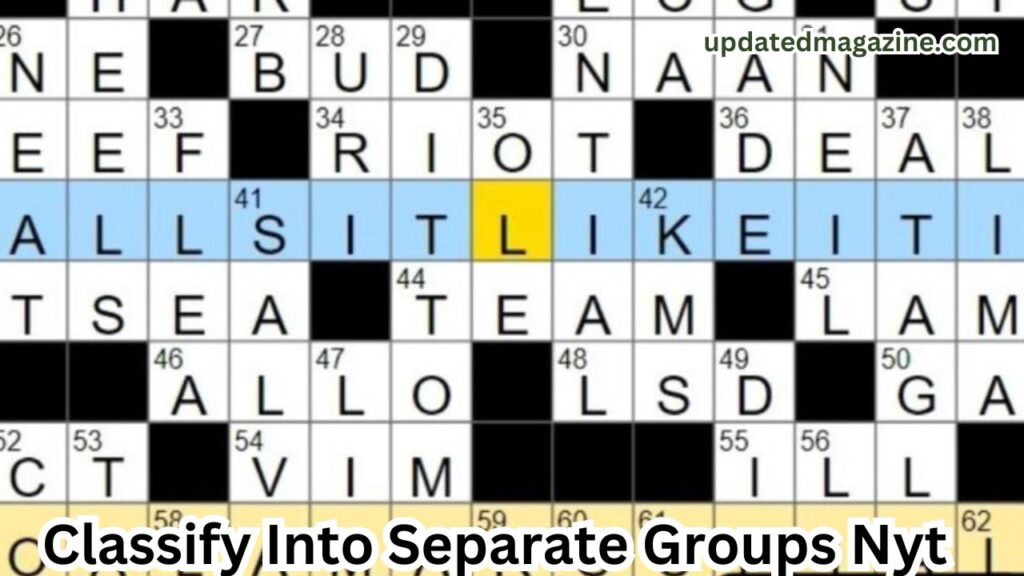Crossword puzzles are a beloved pastime, challenging solvers to think critically and creatively. But have you ever considered the underlying strategy that goes into cracking these puzzles? To classify into separate groups nyt when tackling crossword clues is a technique that can elevate your solving game. This process involves categorizing clues based on common patterns, meanings, or wordplay types, leading to more efficient and enjoyable puzzle solving.
This article will explore the methods and strategies to classify into separate groups nyt within the context of crossword puzzles. By understanding how to group crossword clues, you can enhance your ability to decipher even the most challenging grids.
The Role of Group Classification in Crossword Solving
Grouping crossword clues is an essential technique for seasoned solvers. It helps in organizing clues based on their type, difficulty, or the wordplay involved, allowing for a more systematic approach to solving.
Why Classify Crossword Clues into Separate Groups Nyt?
At the New York Times, crossword puzzles are known for their clever wordplay and intricate clues. Classifying these clues into separate groups can help solvers identify patterns and solve the puzzle more efficiently. For instance, recognizing that a set of clues involves anagrams or homophones allows you to apply specific strategies tailored to those types of wordplay.
Pattern Recognition in Crossword Clues
Grouping clues by pattern recognition is a powerful tool. Whether it’s identifying puns, abbreviations, or hidden word indicators, classifying clues into these distinct groups can make the solving process smoother and more intuitive.
Principles of Group Classification in Crossword Puzzles
To effectively classify crossword clues, solvers should follow certain principles that ensure the classification is useful and aids in the solving process.
Identifying Wordplay Types
Crossword clues often involve various types of wordplay, such as anagrams, homophones, or double definitions. Identifying and grouping these wordplay types is the first step in classifying clues. This allows you to apply the appropriate solving techniques to each group.
Grouping by Difficulty
Clues can also be grouped by their difficulty level. Some clues might be straightforward definitions, while others involve complex wordplay or obscure references. Grouping clues by difficulty can help you tackle the easier ones first, building momentum for the more challenging parts of the puzzle.
Consistency in Interpretation
When classifying crossword clues, it’s important to maintain consistency in your interpretation. For instance, if you classify a clue as an anagram indicator, ensure that this classification is applied consistently across similar clues. This approach will help in developing a systematic solving method.
Techniques to Classify Crossword Clues Nyt
Several techniques can be employed to classify crossword clues into separate groups nyt, each helping solvers approach puzzles with a more organized strategy.
Thematic Grouping
Crossword puzzles, especially those from the nyt, often have a theme. Grouping clues that relate to this theme can provide insight into the puzzle’s structure and make solving easier. For instance, if the theme involves famous authors, you might group all literary references together.
Categorizing Clues by Wordplay Indicators
Many crossword clues use specific indicators that suggest the type of wordplay involved. Words like “confused,” “scrambled,” or “mixed” might indicate an anagram. Grouping these clues together can help you quickly identify the solving technique required.
Cluster Solving
Cluster solving involves focusing on a group of interconnected clues within the grid. By classifying these clues together, you can solve them as a cluster, which often reveals patterns or letters that assist in solving adjacent clues.
Applications of Group Classification in Nyt Crossword Puzzles
The New York Times crossword puzzles are a perfect playground for applying group classification techniques. These methods can be particularly useful for solving both daily puzzles and the more challenging Sunday grids.
Identifying Puzzle Themes
Themes are a hallmark of nyt crossword puzzles. By classifying clues that align with the puzzle’s theme, solvers can often unlock key answers that make the rest of the puzzle fall into place. For example, in a puzzle themed around U.S. Presidents, grouping all clues related to political history can streamline the solving process.
Breaking Down Complex Wordplay
Complex wordplay is a staple of nyt crosswords. By classifying clues based on their wordplay type—such as anagrams, homophones, or charades—solvers can approach these tricky clues with the right strategies in mind.
Tracking Crossword Difficulty
Nyt puzzles increase in difficulty as the week progresses, with Monday puzzles being the easiest and Saturday’s being the most challenging. Grouping clues by difficulty not only helps in individual puzzles but also allows solvers to prepare for the escalating complexity throughout the week.
Challenges in Classifying Crossword Clues
While grouping clues can be immensely helpful, it also presents certain challenges that solvers need to be aware of.
Ambiguity in Clue Interpretation
One of the biggest challenges in classifying crossword clues is the ambiguity in their interpretation. A clue might have multiple potential meanings, making it difficult to categorize. For instance, a clue like “Lead role” could refer to an actor in a movie or the chemical element lead.
Overlapping Wordplay Types
Some crossword clues involve more than one type of wordplay, such as a cryptic definition that also contains an anagram. These overlapping types can complicate the classification process, requiring solvers to be flexible in their approach.
Dynamic Nature of Puzzles
Crossword puzzles are dynamic, with clues often influencing one another as you solve. This interconnected nature can make it challenging to classify clues in isolation, as the solution to one clue might depend on the classification of another.
Strategies to Improve Crossword Clue Classification
To address these challenges, solvers can employ several strategies to enhance their ability to classify crossword clues effectively.
Practice Consistent Grouping
Regular practice in grouping clues can help in developing a consistent approach. Over time, you’ll become more adept at recognizing wordplay types and patterns, making it easier to classify clues quickly and accurately.
Use a Puzzle-Specific Approach
Different puzzles might require different approaches to classification. For instance, a themed puzzle might benefit more from thematic grouping, while a cryptic crossword might require a focus on wordplay types. Tailoring your classification strategy to the specific puzzle at hand can lead to more effective solving.
Leverage Technology and Resources
Online tools and crossword dictionaries can aid in the classification process by providing insights into common clue types and wordplay indicators. Leveraging these resources can help solvers classify clues more efficiently and accurately.
The Future of Crossword Clue Classification at Nyt
As crossword puzzles continue to evolve, so too will the techniques used to classify clues. Advances in technology and puzzle design are likely to introduce new challenges and opportunities for solvers.
AI and Machine Learning in Crossword Solving
Artificial intelligence and machine learning have the potential to revolutionize crossword solving by automating clue classification and suggesting potential answers. For nyt puzzles, this could lead to more interactive and personalized solving experiences, where the puzzle adapts to the solver’s classification style.
Increased Puzzle Complexity
As puzzles become more complex, with layered themes and intricate wordplay, the ability to classify clues effectively will become even more important. Solvers will need to stay ahead by continuously refining their classification strategies and adapting to new types of clues.
Enhanced Solver Experience
Ultimately, the goal of improving crossword clue classification is to enhance the solver’s experience. By developing more efficient and effective classification techniques, solvers can enjoy a more satisfying and rewarding puzzle-solving process.
Conclusion
To classify into separate groups nyt when solving crossword puzzles is a powerful technique that can significantly enhance your ability to crack even the most challenging grids. By adhering to principles of classification, employing effective techniques, and staying adaptable to new puzzle trends, you can develop a more systematic approach to solving crosswords. Whether you’re tackling a daily nyt puzzle or a more complex weekend grid, mastering the art of crossword clue classification will undoubtedly make your solving experience more enjoyable and successful.
Also Read: A Comprehensive Guide to Codes eTrueSports
FAQs
What is the importance of classifying crossword clues in solving puzzles?
Classifying crossword clues helps in organizing the solving process, making it easier to identify patterns and apply the right strategies for different types of wordplay.
How does the New York Times use crossword clue classification?
The New York Times crossword puzzles often include themed clues and complex wordplay, making classification a useful tool for solvers to navigate the puzzle efficiently.
What challenges arise in classifying crossword clues?
Challenges include ambiguity in clue interpretation, overlapping wordplay types, and the dynamic nature of crossword puzzles, which can make classification difficult.
How can technology aid in crossword clue classification?
Technology, particularly AI and crossword-solving tools, can help solvers by automating the classification process and providing insights into common clue types and patterns.
What are some strategies for improving crossword clue classification?
Strategies include practicing consistent grouping, using puzzle-specific approaches, and leveraging technology and resources to enhance the classification process.
How does group classification enhance the crossword-solving experience?
Group classification allows solvers to approach puzzles more systematically, making it easier to identify patterns, solve clues, and ultimately enjoy a more rewarding solving experience.












